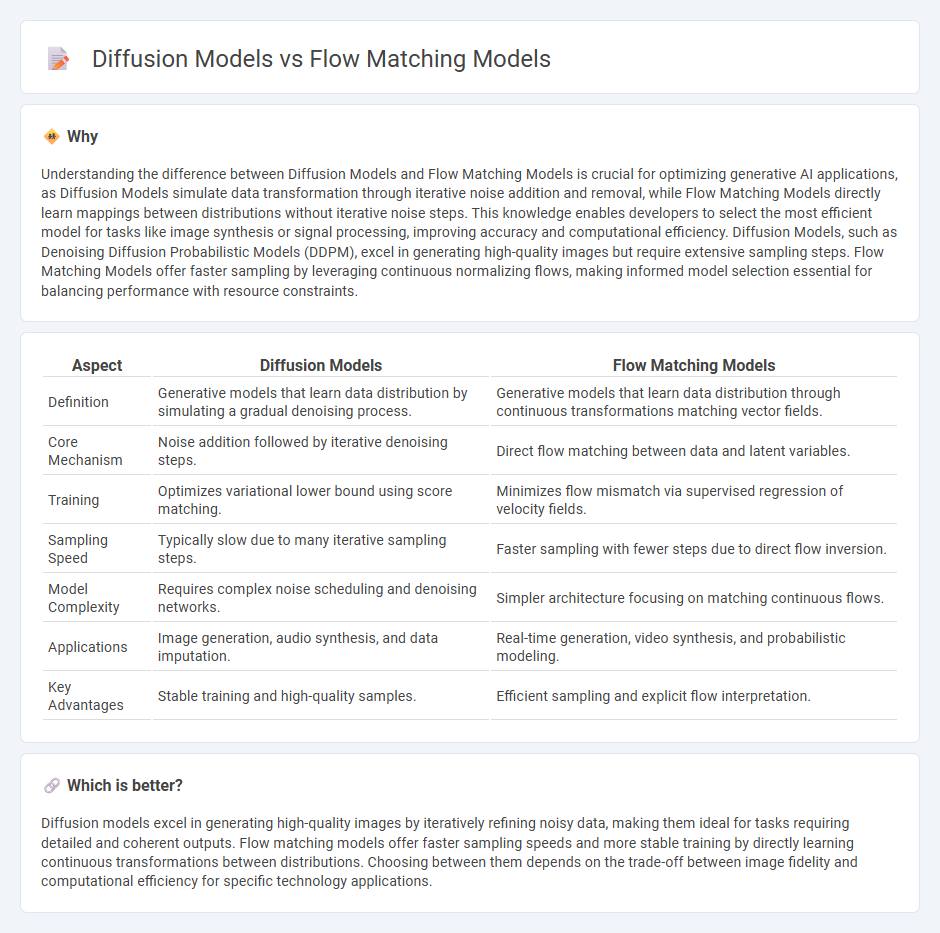
Diffusion models simulate the gradual transformation of data through iterative noise reduction, excelling in generating high-quality images and audio. Flow matching models focus on learning deterministic mappings between data distributions by estimating continuous velocity fields, enabling efficient data synthesis with fewer sampling steps. Explore the distinctions between these cutting-edge generative techniques to understand their strengths and applications.
Why it is important
Understanding the difference between Diffusion Models and Flow Matching Models is crucial for optimizing generative AI applications, as Diffusion Models simulate data transformation through iterative noise addition and removal, while Flow Matching Models directly learn mappings between distributions without iterative noise steps. This knowledge enables developers to select the most efficient model for tasks like image synthesis or signal processing, improving accuracy and computational efficiency. Diffusion Models, such as Denoising Diffusion Probabilistic Models (DDPM), excel in generating high-quality images but require extensive sampling steps. Flow Matching Models offer faster sampling by leveraging continuous normalizing flows, making informed model selection essential for balancing performance with resource constraints.
Comparison Table
| Aspect | Diffusion Models | Flow Matching Models |
|---|---|---|
| Definition | Generative models that learn data distribution by simulating a gradual denoising process. | Generative models that learn data distribution through continuous transformations matching vector fields. |
| Core Mechanism | Noise addition followed by iterative denoising steps. | Direct flow matching between data and latent variables. |
| Training | Optimizes variational lower bound using score matching. | Minimizes flow mismatch via supervised regression of velocity fields. |
| Sampling Speed | Typically slow due to many iterative sampling steps. | Faster sampling with fewer steps due to direct flow inversion. |
| Model Complexity | Requires complex noise scheduling and denoising networks. | Simpler architecture focusing on matching continuous flows. |
| Applications | Image generation, audio synthesis, and data imputation. | Real-time generation, video synthesis, and probabilistic modeling. |
| Key Advantages | Stable training and high-quality samples. | Efficient sampling and explicit flow interpretation. |
Which is better?
Diffusion models excel in generating high-quality images by iteratively refining noisy data, making them ideal for tasks requiring detailed and coherent outputs. Flow matching models offer faster sampling speeds and more stable training by directly learning continuous transformations between distributions. Choosing between them depends on the trade-off between image fidelity and computational efficiency for specific technology applications.
Connection
Diffusion models and Flow Matching Models both leverage stochastic processes to generate data by transforming simple distributions into complex ones through iterative refinement. Diffusion models reverse a gradual noising process, while Flow Matching Models optimize continuous transformations by matching vector fields, enabling efficient sampling. Their connection lies in modeling data generation as a continuous transformation, enhancing advancements in generative AI and probabilistic modeling.
Key Terms
Stochastic Differential Equations (SDEs)
Flow matching models leverage vector fields to transform data distributions through deterministic ODEs, while diffusion models rely on stochastic differential equations (SDEs) to gradually add and remove noise, enabling high-quality generative modeling. Diffusion SDEs are defined by drift and diffusion coefficients controlling the forward noising and backward denoising processes, whereas flow matching simplifies this by directly matching vector fields in the latent space, often leading to faster sampling. Explore the underlying mathematics and practical impacts of these approaches to deepen your understanding of generative modeling frameworks.
Probability Flow ODEs
Probability Flow Ordinary Differential Equations (ODEs) provide a deterministic approach to flow matching models, contrasting with the stochastic nature of diffusion models in generative modeling. These ODEs trace the evolution of data distribution continuously over time, enabling exact likelihood computation and more stable training processes. Explore how Probability Flow ODEs enhance model efficiency and sample fidelity compared to traditional diffusion techniques.
Score Function
Flow matching models leverage continuous normalizing flows to estimate data distributions by directly modeling transformations between latent and observed variables, optimizing a flow-based objective function. Diffusion models rely on the score function to iteratively denoise data through reverse-time stochastic differential equations, estimating gradients of the log-density function for effective sample generation. Explore detailed comparisons and practical implementations to deepen understanding of score function roles in generative modeling.
Source and External Links
An introduction to Flow Matching * Cambridge MLG Blog - Flow Matching (FM) is a new generative modeling paradigm that merges ideas from Continuous Normalizing Flows and Diffusion Models, addressing key challenges in both, to efficiently learn probabilistic models and generate new data samples.
Flow Matching for Generative Modeling - OpenReview - Flow matching is a simulation-free training method for continuous-time normalizing flows that involves directly regressing vector fields along a probability path, improving training and sampling efficiency compared to diffusion models, and connecting to optimal transport theory.
NeurIPS Tutorial Flow Matching for Generative Modeling - This tutorial provides a comprehensive introduction to flow matching, explaining the core idea of regressing conditional velocities for data generation and exploring extensions to various domains including images, video, molecules, and language, with practical examples and a library release.
 dowidth.com
dowidth.com